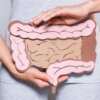
What is the Elemental Diet & is it right for you?
The elemental diet is a therapeutic liquid diet that is prescribed for a range of conditions that includes IBS, SIBO and inflammatory bowel diseases.
An elemental diet is to be followed under the supervision of a medical professional. This would include a dietician, nurse, doctor or gastroenterologist.
This article will discuss how the diet helps and for which conditions.
What is the elemental diet?
This dietary approach is a liquid diet that is used as a treatment for conditions that involve the digestive system.
The elemental formula is a powder that is mixed with water which provides adequate nutrition for the patient.
This powder contains protein, fat and carbohydrates in a very easy-to-digest form. This means that this pre-digested formula can be very easily absorbed in the gut, without triggering digestive symptoms.
How long it is followed depends on the conditions. For example, when the elemental diet is used as a treatment for SIBO it is followed for 2-6 weeks. [1]
How does the elemental diet work?
The elemental diet is understood to work in a few central ways. These are related to the microbial balance of the digestive system as the inflammatory and immunological response.
Bowel Rest. Since there is no fibre in the elemental diet, it is very easy to absorb, particularly in the first part of the small intestine. As digestion requires a lot of energy, reducing the need for digestion allows the gut to focus on repair processes. [2]
Gut Bacteria. Due to gut bacteria requiring prebiotic fibres for their growth, eliminating these with the elemental formula can inhibit their replication and stop them from growing. They have also been indicated to help with fungal imbalance in the gut.
Anti-inflammatory. Many gut conditions can involve a form of inflammation. It can often be this inflammation that contributes to changes in the gut microbiome. This inflammation can be triggered by an immunological response, which is often the case in SIBO as well as Crohn’s. The elemental formula removes allergenic substances that can calm the immune response, reducing inflammation. [3]
All of these factors can combine to form a type of gut reset.
Can the elemental diet be used to lose weight?
One of the uses and aims of the elemental diet is to provide adequate calories for the patient. This may be due to digestive issues preventing solid foods from being tolerated.
This means that the introduction of an elemental diet is often prescribed to help maintain calorie intake and prevent weight loss.
However, it can be the case the amount of the liquid formula to drink to maintain calories may lead to discomfort to feeling overly full. This in turn may then lead to reduce intake and therefore reduced calories with weight loss as the result.
What conditions are treated with the elemental diet?
A range of gut conditions can be treated with the elemental diet. These have varying degrees of research behind them.
The inflammatory bowel condition, Crohn’s disease is the most well-researched but further conditions have also been found to benefit from elemental diet treatment.
These include:
- IBS
- SIBO
- Coeliac disease
- Eosinophilic oesophagitis
- Pancreatitis
Who is the diet not recommended for?
While the diet should be used under the care of a medical professional, there are certain situations where the diet should not be used.
In those with diabetes, the diet should not be recommended. This is due to the elemental formulas containing refined carbohydrates, which can lead to elevations (spikes) in blood sugar. This disruption in blood sugar levels can increase the issues faced by diabetics.
Additionally, the diet is not recommended for those trying to lose weight. The aim of the diet is to ensure calories are maintained and weight is not lost.
Starting the Elemental diet
Once the elemental diet has been prescribed, there are 2 ways to consider starting the diet.
The first is a transitional period of 2-4 days. This can be where replacing 1 meal at a time with the formula can make the starting of the diet more gradual.
The second way to start the diet is to replace all calories with the formula from the first day. For many, this may be the best option as starting the diet quicker may feel easier.
Finishing the diet
Once the diet has been followed for the appropriate amount of time, a gradually introduction process can then be considered.
This allows for certain foods to be reintroduced slowly, starting with the least allergenic/potentially problematic.
Least Allergenic Foods
These foods can be introduced first, for a period of 5-7 days.
- Vegetables (non-legumes): carrots, squashes, potatoes, broccoli, lettuce, beets, asparagus, cauliflower, brussels sprouts, cabbage, kale, tomatoes, celery, cucumbers, onions, and garlic
- Fruits (non-citrus, non-tropical): apples, pears, peaches, plums, apricots, nectarines, and grapes.
Minimally Allergenic Foods
These foods can be introduced for a period of 5-7 days.
- Citrus fruits: oranges, grapefruits, limes, and lemons
- Tropical fruits: bananas, kiwis, pineapples, mangos, avocados, and papayas
- Other fruits: melons and berries
- Grains: rice, millet, and quinoa
Moderately Allergenic Foods
These foods can be introduced for a period of 5-7 days.
- Legumes: beans (not soy) and green beans
- Grains: oats, barley, rye, and other non-wheat grains
- Meat: lamb, chicken, pork, and turkey
Most Allergenic Foods
Add one food at a time.
- Common food allergens: fish/shellfish, nuts, peanuts, corn, peas, beef, soy, egg, wheat, and dairy.
If a food leads to an increase in symptoms, this may need to be eliminated for the time being. [5]
Are there any side effects and how to manage them?
While the elemental diet is generally well tolerated, side effects are still possible. These may last for a short period as the diet is started. In other cases, these may continue for the duration of the diet and make it hard to complete.
- Abdominal discomfort or cramping may be related to a certain ingredient in the formula but also may be present in the short term as the gut adapts. Additionally, many with digestive issues can have slow motility, and if the formula is calming the underlying irritation, more stool may be passing through the bowel, leading to these symptoms.
- Weight loss can occur with the elemental diet but only if not enough of the formula is being consumed. The amount needed to maintain calories will be indicated by the prescribing doctor or nurse. For some, this volume of fluid may prove challenging and lead to nausea or feeling overly full.
- Constipation can also occur with the elemental diet. This is due to the low-fibre nature of the diet and how it can reduce the bulk required to help with bowel movements. This is not normally cause for concern.
- Other side effects can include hunger, fatigue, head and mood changes. This can often be due to diet being a liquid diet which can feel very different for most patients when compared to eating normal food.
If side effects occur, these are best discussed with the nurse, doctor or dietician who prescribed the diet.
The bottom line: Should you try the elemental diet?
The elemental diet is a well-researched approach to a range of digestive as well as immunological conditions.
For chronic health conditions, it may not be the first approach that is considered as often, less extreme approaches are often helpful. However, in appropriate situations, the elemental diet can be extremely helpful and not only reduce symptoms but improve quality of life.







